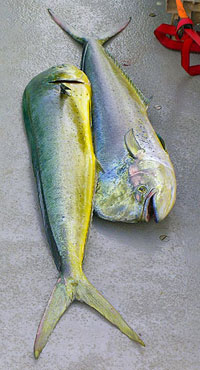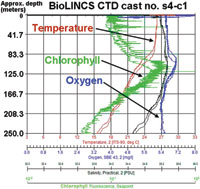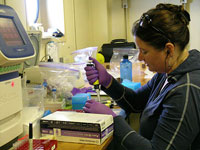- C-MORE Home
- What is Microbial Oceanography?
- What is C-MORE?
- Research
- • Research Cruises
- » BioLINCS
- Home
- Cruise Participants
- Instruments Used
on the Cruise - Nitrogen Cycling
- Marine Microbes
- Cruise Blog
- Data Archive
- Education & Outreach
- People
- Publications
- Image Library
- Contact Us
| |||||||||||||||||||||||||||||||||||
BioLINCS Cruise Blog
Sunday, September 11, 2011
|
This morning, marine technician Kuhio Vellalos, of the University of Hawaii, caught these two beautiful mahi mahi using just a hand line. It’s hard to imagine that the lives of these large fish ultimately depend on the miniscule organisms that we are studying on this cruise. |
|
This plot from a recent CTD cast shows some of the common features of the water column in this part of the ocean, including a “deep chlorophyll maximum” at about 110 meters. This peak in chlorophyll concentration is caused by a ubiquitous type of marine bacteria known as Prochlorococcus. |
|
Kendra Turk-Kubo from the University of California, Santa Cruz, prepares samples for a type of DNA analysis called ”qPCR” (quantitative polymerase chain reaction). This technique allows researchers to determine the relative abundance of different types of microorganisms in the water, based on their DNA. |
Today we took a little break from babysitting the Environmental Sample Processor (ESP), and headed back to the spot where we launched the ESP, in hopes that microbes would be more abundant there. We motored down to the spot, took a CTD cast, and collected water samples this morning. As I write this, we are heading back north to rendezvous with the ESP once again.
The weather continues to be amazing, with sunny skies, steady five knot winds, gentle five- to seven-foot seas, and just a few clouds on the horizon. I could sail an eight-foot dinghy out here with no worries (other than the fact that we’re perhaps 80 miles from the nearest land).
While the microbiologists on board the ship are searching for tiny marine organisms that are maybe 1/50th the diameter of a human hair, the marine technicians on the ship are looking for larger prey. This morning Kuhio Vellalos caught two good-sized mahi mahi using just a hand line thrown over the stern of the ship. Yesterday Blake Watkins caught an ono (wahoo) using similar gear. The chefs did justice to these beautiful fish tonight, cooking them to perfection and also making poke (Hawaiian-style raw fish).
So now we’ve become part of the same food chain that we are studying. We ate a mahi mahi that probably ate lots of small fish. The small fish ate lots of tiny, shrimp-like copepods, which ate some microscopic dinoflagellates, which may have eaten some marine protozoans, which perhaps ate miniscule heterotrophic bacteria, which may have consumed some of the microbes that we are studying on board the ship.
As this example illustrates, “food chains” in the open ocean can be quite long, with microscopic organisms making up a majority of the links. In this example, we, the top predators in the food chain, are studying the bottom link in the food chain, the microbes that are collecting energy from the sun and sharing it with the rest of us. Even though we may be traversing an oceanic “desert,” there’s still plenty of life out here.
Every time we take a CTD cast, we see graphic evidence of the primary producers that are keeping this whole system going. In addition to collecting water samples, each CTD rosette carries a suite of instruments to measure water temperature, salinity, oxygen concentration, and the amount of chlorophyll in the water. The amount of chlorophyll is particularly important, because it indicates how dense the populations of algae or photosynthetic microbes are at various depths.
Looking at the plot from yesterday’s first CTD run (center right), you can see a number of interesting features (I’m sorry that the depth scale on the left is not very intuitive). The different colored lines indicate different water characteristics, with values increasing toward the right side of the graph. Each line has two traces because the water characteristics are measured both when lowering and raising the CTD array.
The temperature of the seawater is shown as a red line. It starts out at the surface around 26.5° Celsius (80 degrees Fahrenheit), and remains around this temperature down to about 80 meters below the surface. At 80 meters, the CTD reaches what oceanographers call the “thermocline,” a point at which the water temperature begins to drop rapidly. At the bottom of this CTD cast, 250 meters below the surface, the water temperature is a cool 15.5° C (60° F).
The chlorophyll content of the water (green line) shows a distinct peak at about 100 to 110 meters. This “deep chlorophyll maximum” results from large numbers of photosynthetic marine bacteria living at this depth. Somehow these bacteria get enough sunlight to survive through photosynthesis, despite living a long way below the sun-lit sea surface.
The oxygen concentration of the water (blue line) is pretty steady, but shows a small bump about 100 meters below the surface. This local increase in oxygen is probably caused by the marine bacteria in the deep chlorophyll maximum. Just like plants on land, these bacteria release oxygen gas while performing photosynthesis.
Most of the marine bacteria in the deep chlorophyll maximum are part a genus known as Prochlorococcus. Prochlorococcus bacteria are so widespread and abundant in the world’s oceans that some scientists estimate they produce more than 1/3 of the oxygen we breathe. Yet they are so small that marine biologists did not even know they existed until 1988.
Even under a high-powered optical microscope, Prochlorococcus bacteria look like a bunch of little dots. To make matters worse, like many marine bacteria, they can be tough to grow in the laboratory, preferring to grow under very specific conditions and in the company of other microbes. For this reason, most scientists classify marine bacteria and try to figure out how they live by analyzing their genetic material (DNA and RNA).
Researchers such as Kendra Turk-Kubo and Denis Bombar are performing DNA and RNA analyses on board the Kilo Moana to figure out what kinds of microbes and how many of each kind are in the water at different depths. The ESP is doing the same thing automatically as it drifts across the ocean. So far, Kendra’s results appear to be similar to those from the ESP. However, she is seeing a greater variety of microbes because she is collecting samples from many different depths, while the ESP is only collecting seawater from 25 meters below the surface.
In tomorrow’s blog, I’ll describe an amazing instrument that we’re using in concert with these DNA analyses, to identify, count, and even sort individual marine bacteria, one at a time.
[ Top of Page ]






